Google Pixel 8 vs Samsung Galaxy S23: the No Pro battle
We may earn a commission if you make a purchase from the links on this page.
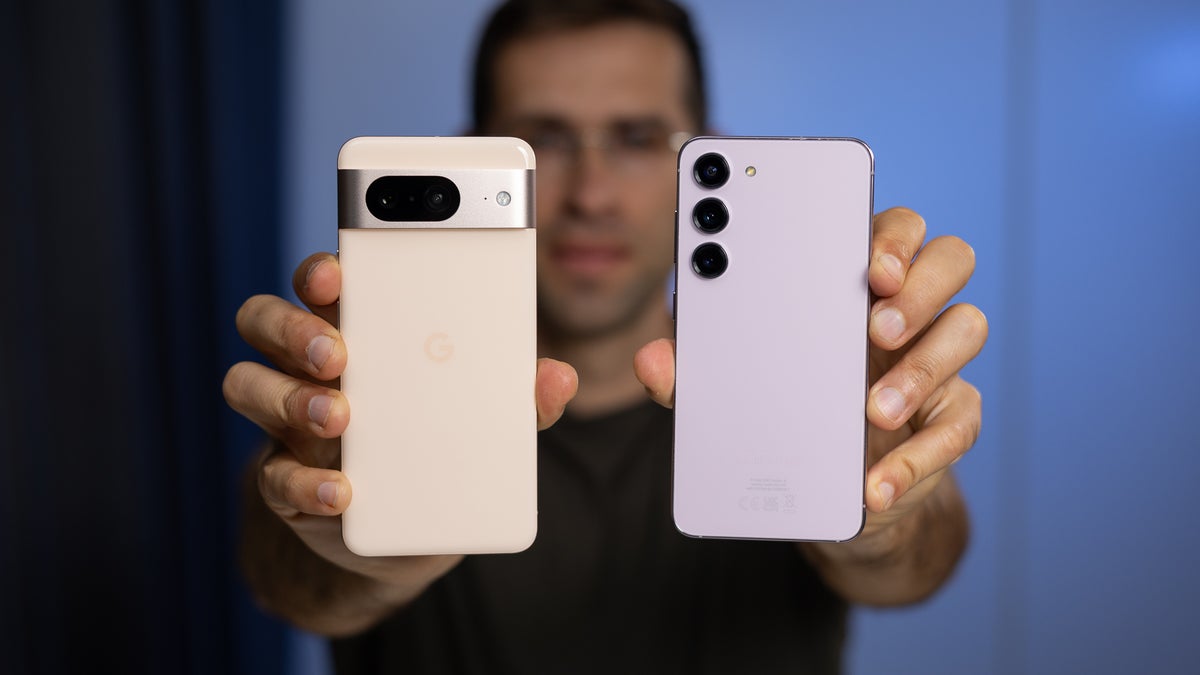
Intro
Google's Pixel 8 lineup is now yesteryear's news, since the Pixel 9 phones launched in August of 2024. But the old Pixel 8 line is still available for sale from Google and no, the prices were not reduced — the Pixel 8 still starts at $699. That's because the new models launched with higher prices, so the old line is technically now the "cheaper option".
Samsung also keeps its old flagships around to sell at slightly lower prices than the newer models. The Galaxy S23 now starts at $759.99, which is only $40 below the Galaxy S24, so you might wonder "Why even bother with the older model?".
Well, whenever promo periods or sales events happen, the year-old flagships are the ones to get the deepest discounts. Especially if you have a phone to trade in. So, while we wouldn't recommend them at MSRP currently, if you are looking at these during Black Friday or some other sales event, here's how they compare:
Google Pixel 8 vs Samsung Galaxy S23 expectations:
- Two compact phones, by today's standards
- Pixel 8 has 2 cameras, S23 adds a third zoom camera
- New image processing algorithms on Pixel might win the camera game
- Tensor G3 is not as powerful as Snapdragon 8 Gen 2
- Advanced AI features and Bard vs... Bixby
- Stock Google Android vs Samsung One UI
Table of Contents:
Read more:
Design and Size
The Pixel is shrinking to compact sizes
The Pixel 8 comes with a 6.2-inch screen and thin bezels — it's slightly smaller than its predecessor, and almost as compact as the Galaxy S23. The latter still wins the one-hand challenge, thanks to its 6.1" screen size.
The Pixel 8 is yet another glass sandwich with an aluminum frame with that distinct horizontal camera bar on the back. While the build materials here are similar, the two phones will look quite different — the Galaxy S23, of course, has the vertical trio of lenses on its back instead.
No curved screens for those models — the arched display corners are only added to the more expensive Pro and Ultra variants nowadays. And also, both of these will have fingerprint scanners embedded in the display.
For biometrics, we have under-screen fingerprint scanners on both, which work similarly quickly and reliably. Also, both phones have face unlock via the selfie cameras, which is typically not considered secure enough. However, Google's machine learning prowess and the new Tensor G3 make the face unlock of the Pixel 8 extremely secure, according to Google — meeting the "highest Android biometric class". Meaning, you will be able to use it to unlock contactless payments through banking apps, as if it were an iPhone with a Face ID array.
Display Differences
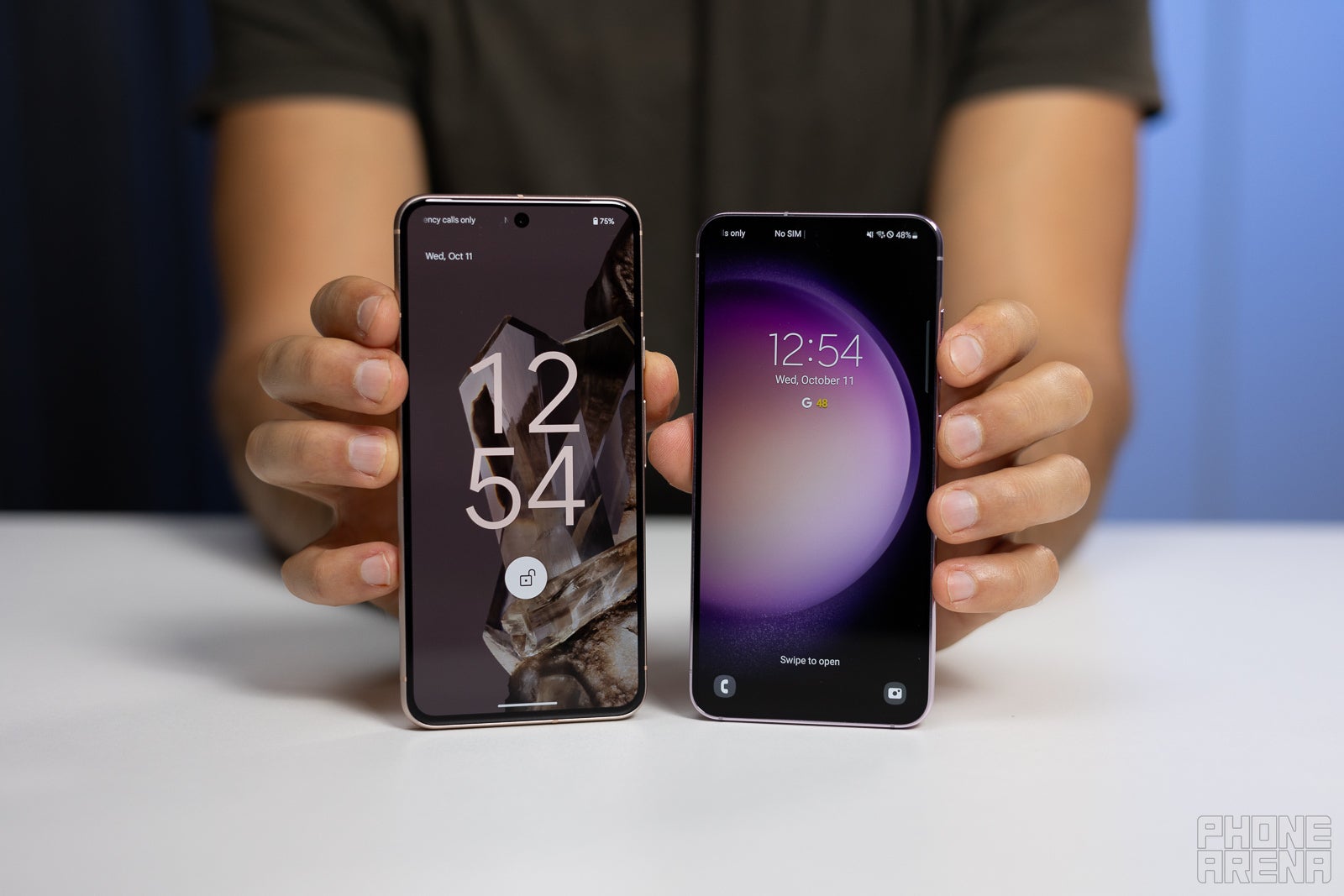
Image credit - PhoneArena
The Pixel 8 now has a 120 Hz OLED screen — much like on the Galaxy S23. Though, Google does tune colors slightly differently, and the new Actua Display that the Pixel has produces extremely high peak brightness numbers — 2,000 nits on paper, vs the Galaxy S23's 1,750 nits.
Of course, we have a couple of calibrations and sliders to use to fine-tune how these screens display colors. And blue-light-filtering night mode is now an industry standard.
Performance and Software
Will the Tensor G3 be a hit?
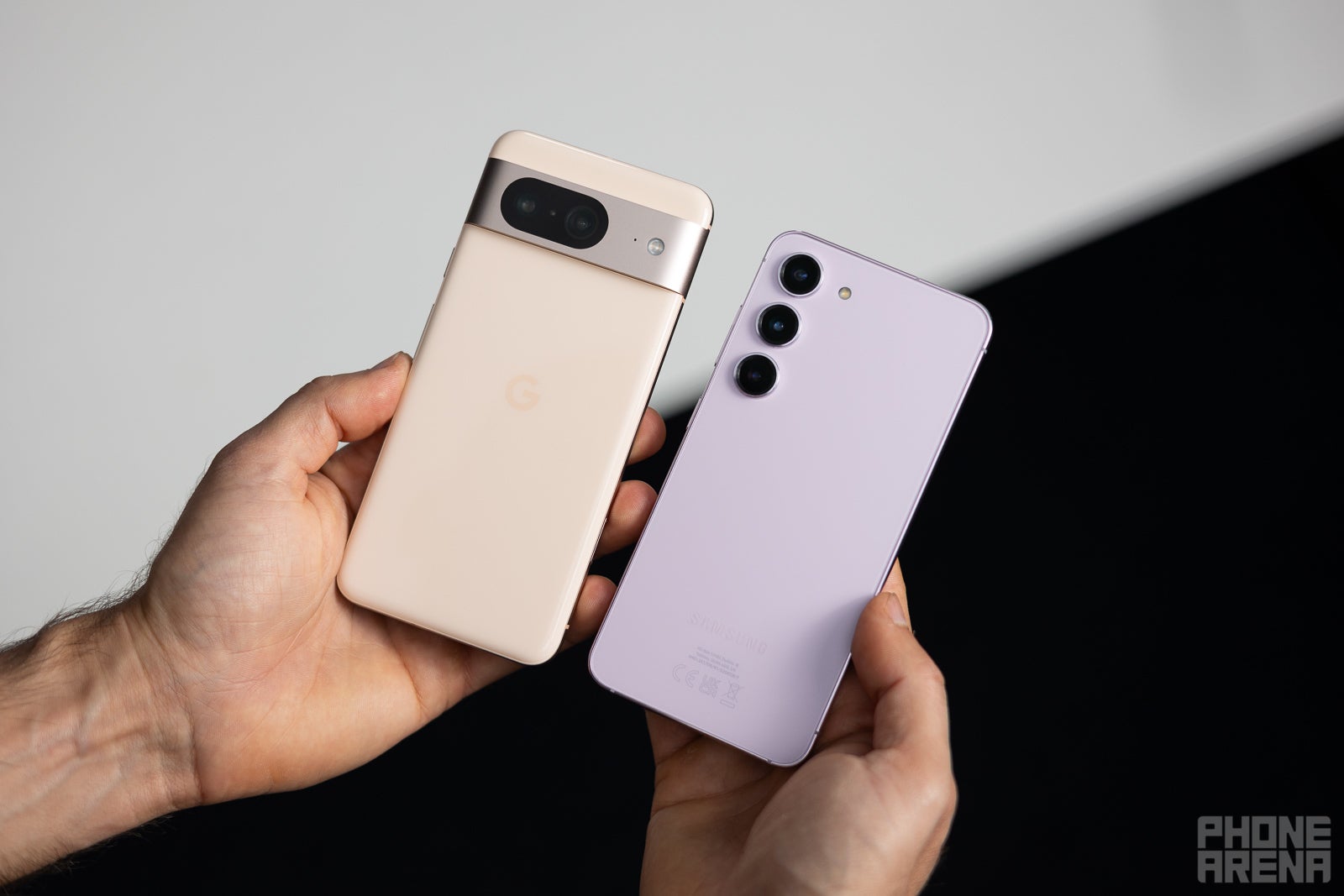
Image credit - PhoneArena
For the third year in a row, we are seeing Google's Pixel phones be powered by a Google-designed chip. The Tensor series is built with special logic cores, dedicated to handling image processing and Google Assistant AI tasks. However, thus far, the Tensors haven't been much for performance — and the new Tensor G3 doesn't really change that formula.
That is to say, it's not a number cruncher and it's not a benchmarks performer. The good news is that we haven't had a performance problem with the Pixels in day-to-day activities in the past, and the Tensor G3 doesn't disappoint us — not unless we decide to play 3D games or export 4K video edits.
The Qualcomm Snapdragon Gen 2 Made for Galaxy inside the Galaxy S23 series, on the other hand, is an absolute heavy-hitter. We have no doubts that this processor can continue to deliver performance overhead for a few years extra, future-proofing the device.
An important note here — if you are shopping for a Galaxy S23, you certainly should pay the small extra for the upgrade to 256 GB storage. That's because the 256 GB tier comes with UFS 4.0 — a new memory module, which is twice as fast as the UFS 3.1 that's found on the base Galaxy S23 variant... and on any of the Pixel 8 models.
The two phones also differ a lot in software and features. The Pixel line is, of course, the vessel to carry Google's Android with the Google Assistant, Bard, and all the developing AI features. The UI is simple, snappy, and straightforward. The Google Photos app has the exclusive Magic Editor, and will have the new Audio Magic Eraser (cleans out ambient sound from a video) and Best Take (lets you stitch up the perfect group shots from different pictures).
Samsung's One UI is based off of Android, but is a complete reskin of the experience. From the quick toggles, to the transparent overlays, an Edge Panel that you can pull in from the side to launch favorite apps, heavy emphasis on split screen, and exclusive tricks in the Samsung Photos App — it, too, holds an Object Eraser and also has the feature where you can crop a subject out of a photo by tapping and holding on it. But Samsung is not as strong in AI as Google is, so these smart features will lack a bit.
But then, there's the whole Samsung ecosystem. Yes, both these manufacturers have smartwathces and earbuds on offer, but Samsung does also make a plethora of smart home appliances, SmartTags, and the SmartThings hub app is the place you control all of them.
There's a good reason why Samsung's Galaxies have established themselves as "the Android phone", and Samsung's effort with ecosystems, syncing with Windows before other Androids were able to do so, making powerful tablets, all of that has played into this. But we can't say we don't find Google's smart features enticing. For the time being, the Pixel phones feel like geek devices that may be a bit scary to the casual user, but exciting to anyone interested in where AI is going.
Oh, here's the big news — the Google Pixel 8 will be getting Android OS updates for 7 years. That means, it should be supported up to 2030 if all goes well. The Galaxy S23 does have a generous 4-year update promise (until 2027)... but it doesn't sound as impressive as what Google announced at the Pixel 8 event!
Camera
Two versus Three, is it a fair fight?
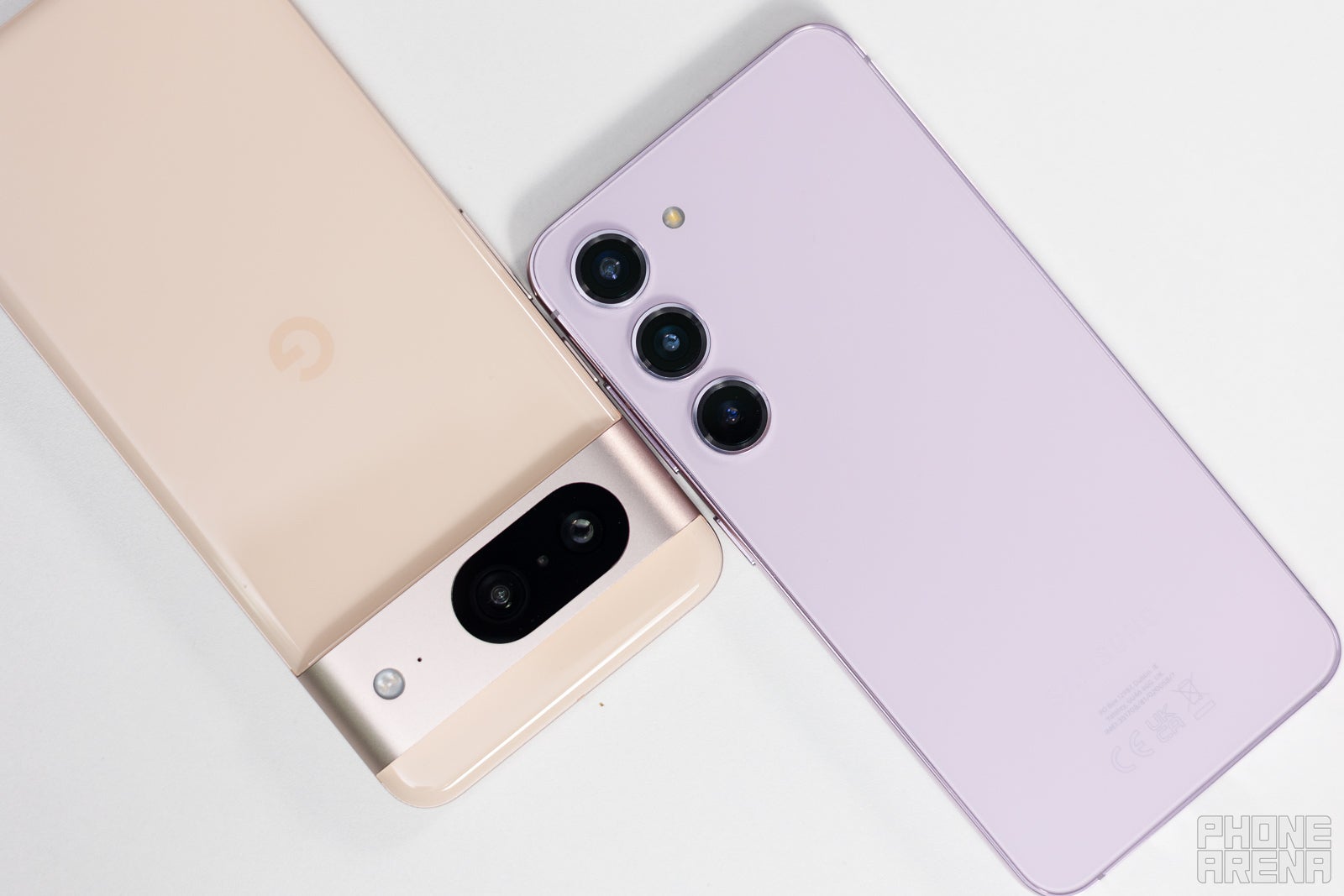
Image credit - PhoneArena
The base Pixel has a 50 MP wide and 12 MP ultra-wide camera. It makes up for the lack of a telephoto lens with Google's SuperRes Zoom algorithms... but our experience with the Pixel 7 has shown us that it's not an ideal solution — especially when you want to take Portrait Mode shots with a zoom-in.
The Galaxy S23 comes with a full trio of cameras, covering ultra-wide, wide, and telephoto lenses, and giving you more flexibility. It feels like a full-blown flagship phone, and not one that cut corners for costs.
Of course, that's just us analyzing the specs and what we know so far — here's what they do:
At night, it seems the Pixel 8 is slightly better at capturing the finer details — it looks like the Galaxy S23 goes a bit too hard with the noise reduction. Then again, maybe its hardware produces the noise that needs dealing with, or the Pixel's AI is doing some heavy lifting behind the scenes. In any case, the Pixel photos here are slightly better with colors, dynamics, details.
The Galaxy S23 has a 3x telephoto lens for a starting point with the zoom shots, meaning the Pixel will have a hard time beating it. And it's seen in these shots — the Galaxy preserves more sharpness and clarity, whereas the Pixel 8 begins to blur at 5x zoom.
Samsung's edge detection and faux bokeh for Portrait Mode shots have been great over the past couple of generations. Yes, even on the cheapest non-Plus, non-Ultra variant. And this is visible here — it manages to preserve the model, their hair and clothes intact. The Pixel uses its main sensor to zoom in, so it loses some resolution, and its edge detection is not great.
Main Camera - Daytime Photos
Consistently, the Pixel 8 has a slight magenta cast, while the Galaxy S23 leans towards a yellow-ish portrayal of scenes. This isn't good or bad, question is whether you prefer the colder or warmer look. We do like skintones on the Galaxy S23 photos here better, but the Pixel 8 seems to have handled dynamics better — the Galaxy S23 can lean towards crushing shadows (sample 8).
Main Camera - Low-light / Night Photos
At night, it seems the Pixel 8 is slightly better at capturing the finer details — it looks like the Galaxy S23 goes a bit too hard with the noise reduction. Then again, maybe its hardware produces the noise that needs dealing with, or the Pixel's AI is doing some heavy lifting behind the scenes. In any case, the Pixel photos here are slightly better with colors, dynamics, details.
Zoom Quality
The Galaxy S23 has a 3x telephoto lens for a starting point with the zoom shots, meaning the Pixel will have a hard time beating it. And it's seen in these shots — the Galaxy preserves more sharpness and clarity, whereas the Pixel 8 begins to blur at 5x zoom.
Portrait Mode
Samsung's edge detection and faux bokeh for Portrait Mode shots have been great over the past couple of generations. Yes, even on the cheapest non-Plus, non-Ultra variant. And this is visible here — it manages to preserve the model, their hair and clothes intact. The Pixel uses its main sensor to zoom in, so it loses some resolution, and its edge detection is not great.
One criticism — the S23's colors may be a bit too vibrant, a bit too comicbook-like for some tastes.
Ultra-wide Camera
Ultra-wide cameras usually have the challenge of distortion and smaller apertures to combat. The Pixel 8 here utilized its software to sharpen details a bit too much, maybe. The leaves, strands of grass, and lines between boards look a bit softer on the Galaxy S23 shots here — depending on the scene, they turn out a bit more realistic, where the Pixel 8 details get a bit too jagged. The color differences follow the same rules as the main cameras — magenta Pixel 8 vs yellow-ish S23.
Selfies
Very similar selfie shots here, but we can see the Galaxy S23 pulling out more details — like wrinkles and other finer bumps — where the Pixel 8 somewhat flattened the whole face.
The Pixel 8 does miss out on a lot of the cool features of the Pixel 8 Pro — like Video Boost or Zoom Enhance, among others. In the end, it might just turn out that it's a slightly improved Pixel 7 camera, which would be a bit of a disappointment, especially with the slight price increase.

Audio Quality and Haptics
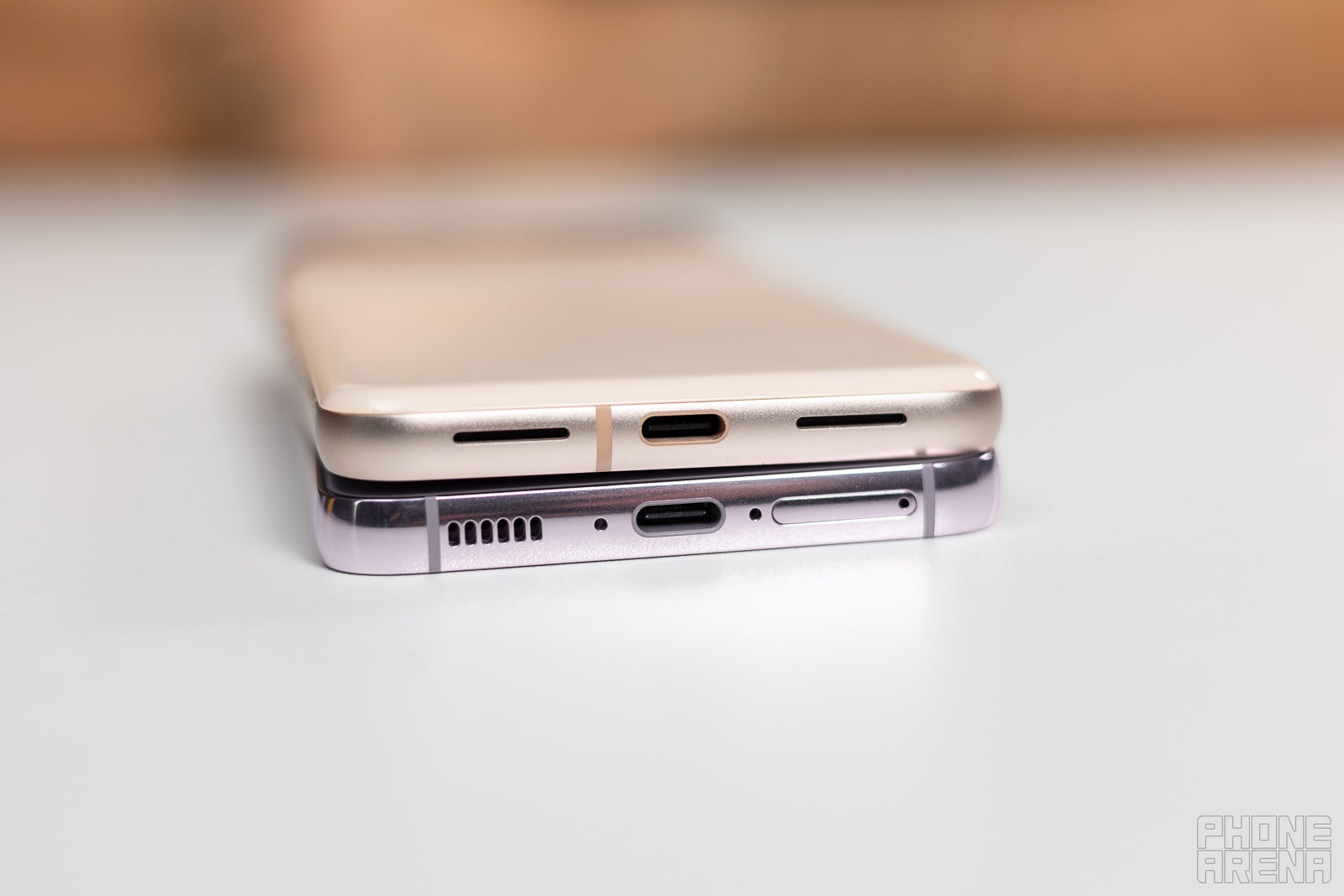
Image credit - PhoneArena
Both of these phones have stereo speakers in the familiar setup — bottom driver and earpiece tweeter. The Galaxy S23 sounds ok — a bit muffled and middy, but it doesn't distort. It does kind of OK for music, but is best used for YouTube talking head videos and TikToks if you will.
Same is the case with the Pixel 8 — one can say it sounds a bit weaker, but we wouldn't say it's definitely a worse speaker. It has a mid hump and sufficient volume, so speech comes out good, while music isn't bassy or pumping.
Haptics on both of these phones are quick, responsive, and satisfying.
Battery Life and Charging
The Pixel 8 may be a tad smaller than the Pixel 7's, but has a surprisingly big battery, rated at 4,575 mAh. The Galaxy S23 itself doesn't have a gargantuan cell — it has a 3,900 mAh powerpack in the back.
So, with a less power-hungry processor, a bigger battery, and first-party software optimizations by Google itself, the Pixel 8 has a chance to really beat the Galaxy S23 in battery endurance. Does it?
PhoneArena Battery Test Results:
In real life, both phones are quite reliable to last a day. Maybe not if you intend to game too much, but then, would you on those tiny screens? For your regular smartphone tasks, social media, YouTube, mails and chats — they will truck through and still have gas in the tank post sunset.
In terms of charging, they are also expected to be similar. The Galaxy can charge at 25 W tops, and the Pixel 8 can support 27 W on the wire. Wirelessly, the Pixel 8 can charge with a 17 W puck, the Galaxy takes up to 15 W.
Specs Comparison
The Google Pixel 8 vs Galaxy S23 specs differ in a few key locations — processors, battery, and storage chips:
| Google Pixel 8 | Samsung Galaxy S23 | |
|---|---|---|
| Size, weight | 5.93 x 2.79 x 0.35 inches (150.5 x 70.8 x 8.9 mm) 6.60 oz (187.0 g) | 5.76 x 2.79 x 0.30 inches (146.3 x 70.9 x 7.6mm) 5.93 oz (168.0 g) |
| Screen | 6.2" OLED 120Hz | 6.1" AMOLED 120Hz |
| Processor | Google Tensor G3 4 nm | Qualcomm Snadpragon 8 Gen 2 "Made for Galaxy" 4 nm |
| RAM, Storage | 8 / 128 GB UFS 3.1 8 / 256 GB UFS 3.1 LPDDR5X | 8 / 128 GB UFS 3.1 8 / 256 GB UFS 4.0 LPDDR5X |
| Cameras | 50 MP main 12 MP ultra 10.5 MP front | 50 MP main 12 MP ultra 10 MP 3X zoom 12 MP front |
| Battery | 4,575 mAh | 3,900 mAh |
| Charging | USB-C 27 W wired 17 W wireless | USB-C 25 W wired 10 W wireless |
Summary and expectations
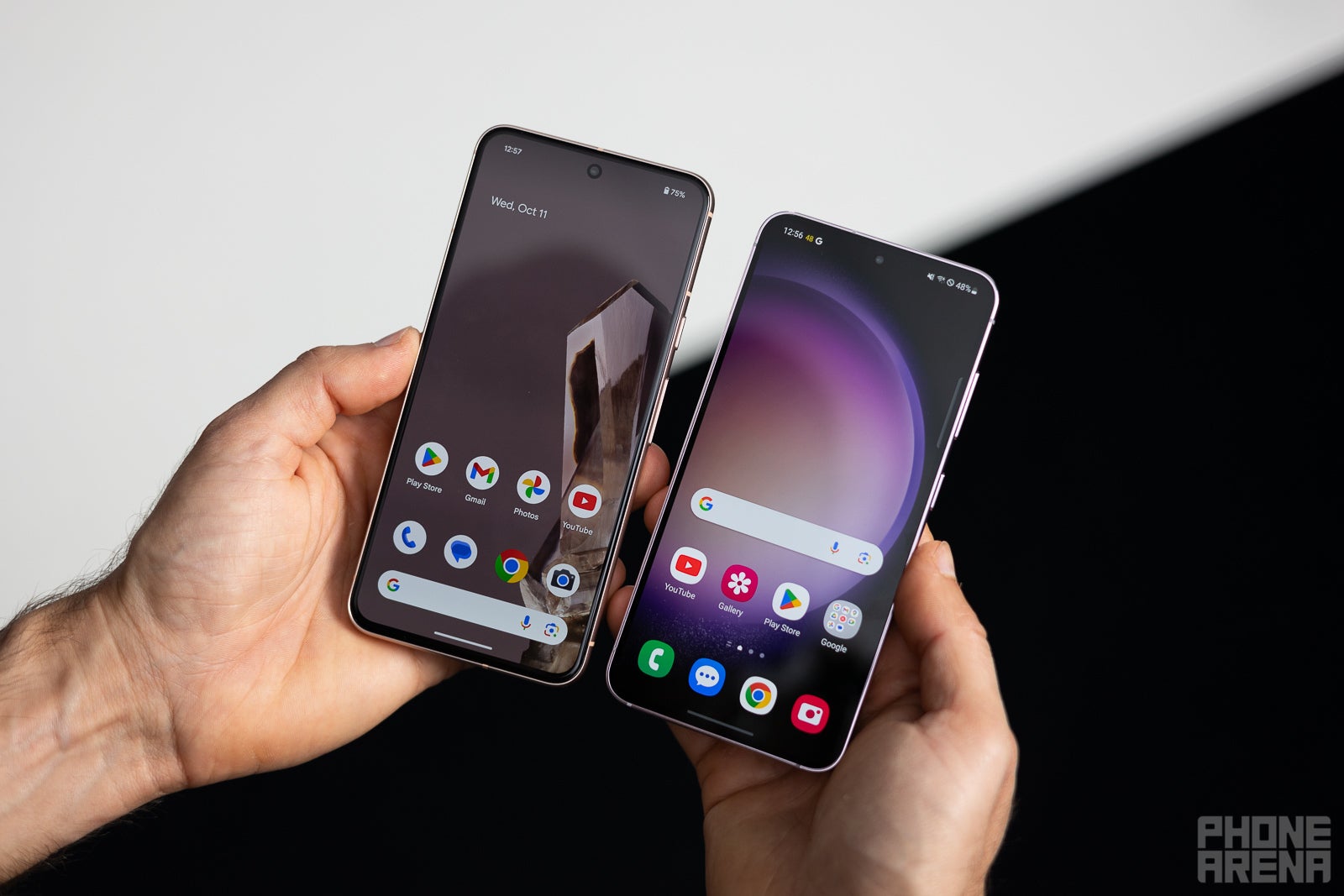
Image credit - PhoneArena
The Pixel 8 wasn't exactly a bargain phone when it launched, as it cut out a lot of features that are present on the $1,000 Pixel 8 Pro. That was a first by Google — typically, the small Pixel and the Pro were closer to each other in previous generations.
On the other hand, the Galaxy S23 starts at $760 (with deals — much less), and doesn't really differ that much from the S23+ above it. As long as you spend a little extra to get a 256 GB Galaxy S23, you will be rocking a modern Samsung flagship through and through.
Now, there's also the argument that the Google Gemini Assistant may or may not be able to do more on the Pixel 8. It's still fresh with the Pixel 9 line and Google was pretty mum about what the older Pixels will get via updates. But... since the Google Store proudly states that the Pixel 8 will be getting Feature Drops and OS updates for 7 years post its original launch date — we kind of have to believe it will get the bulk of the new Gemini features... right?
Bottom line — for more features and better performance — the Galaxy S23 is your bet. For longer software support and possibly more feature drops — we'd bet on the Pixel 8.
Follow us on Google News

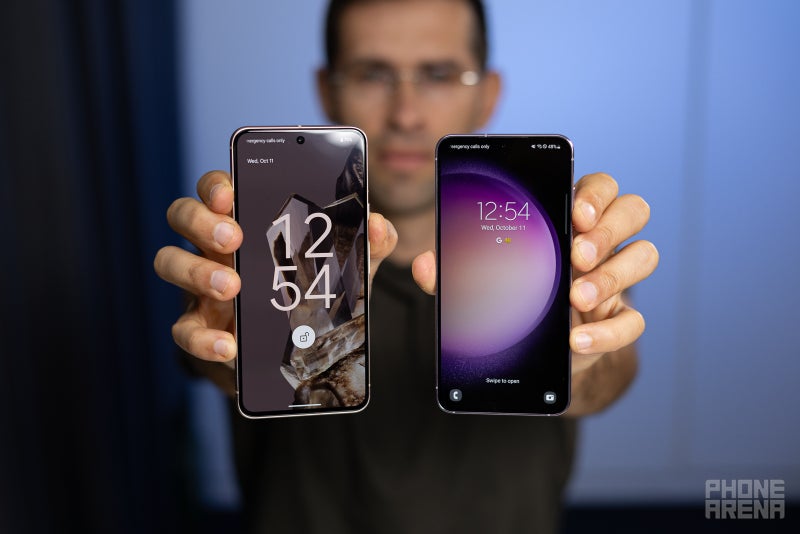
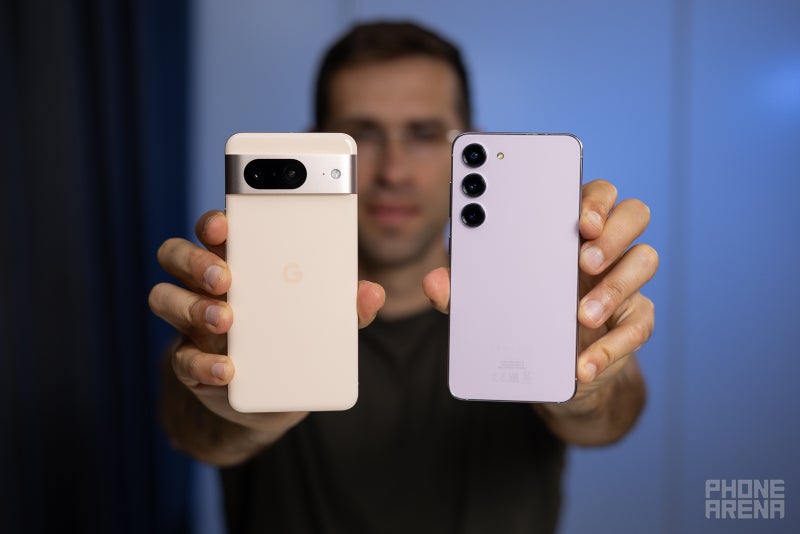

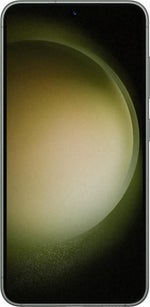











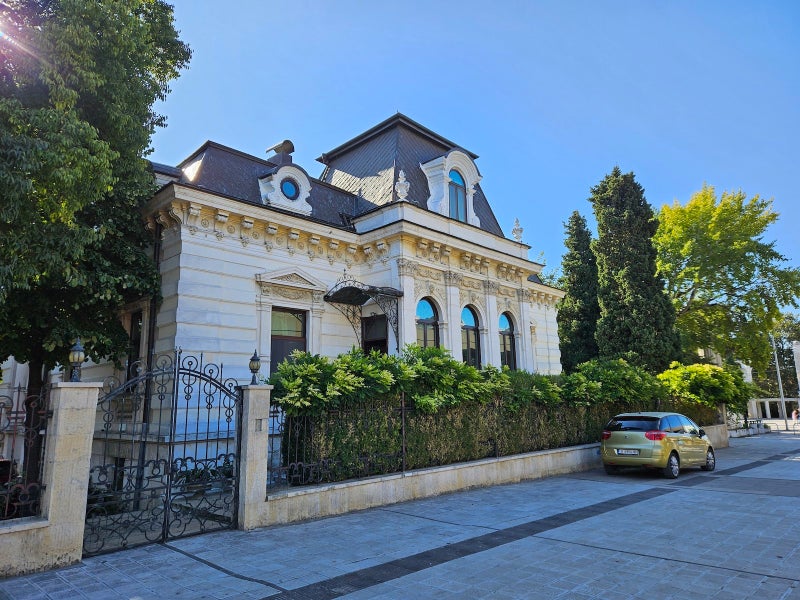




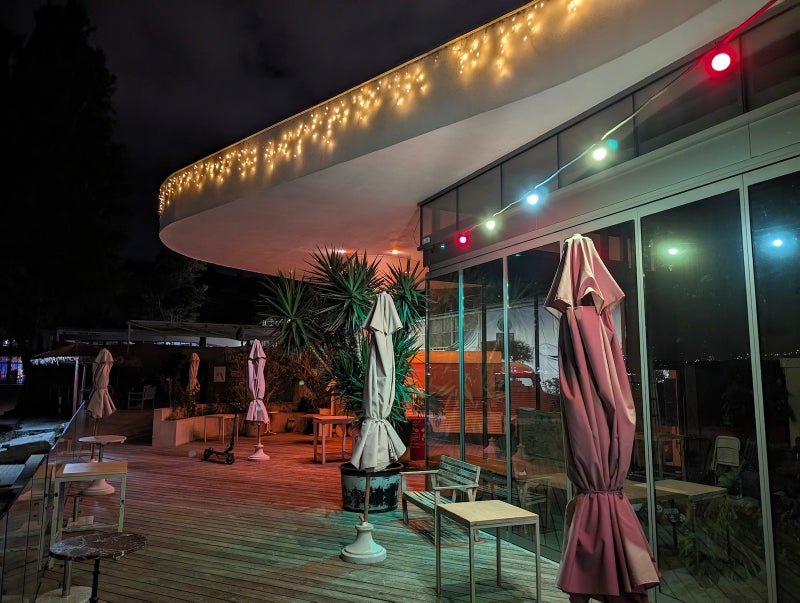
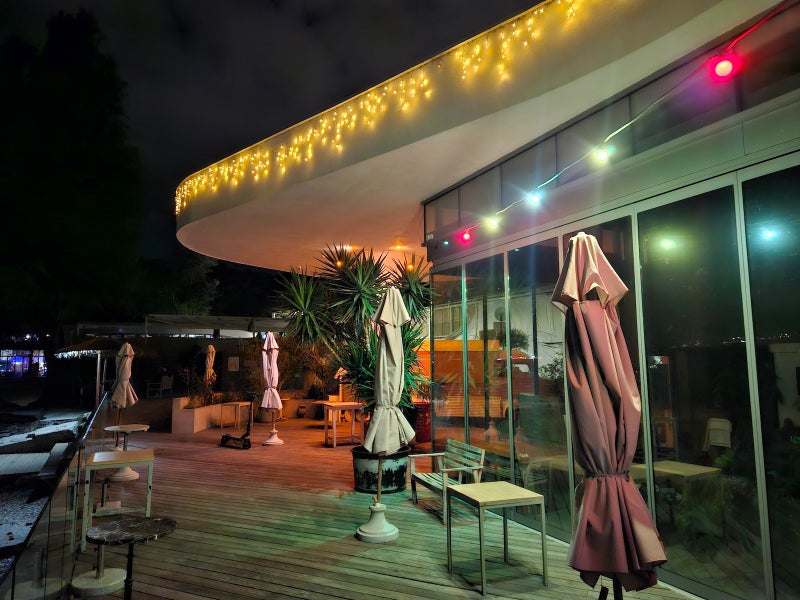










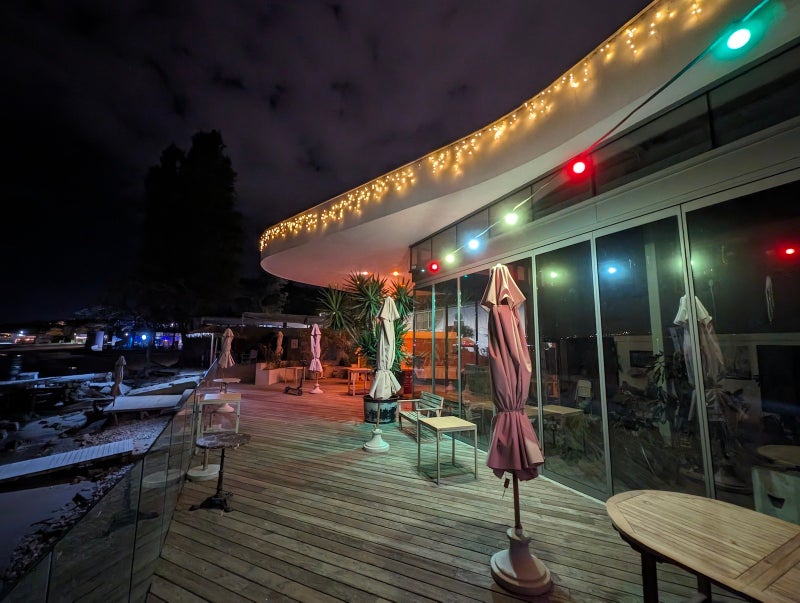



















Things that are NOT allowed:
To help keep our community safe and free from spam, we apply temporary limits to newly created accounts: